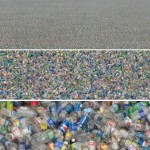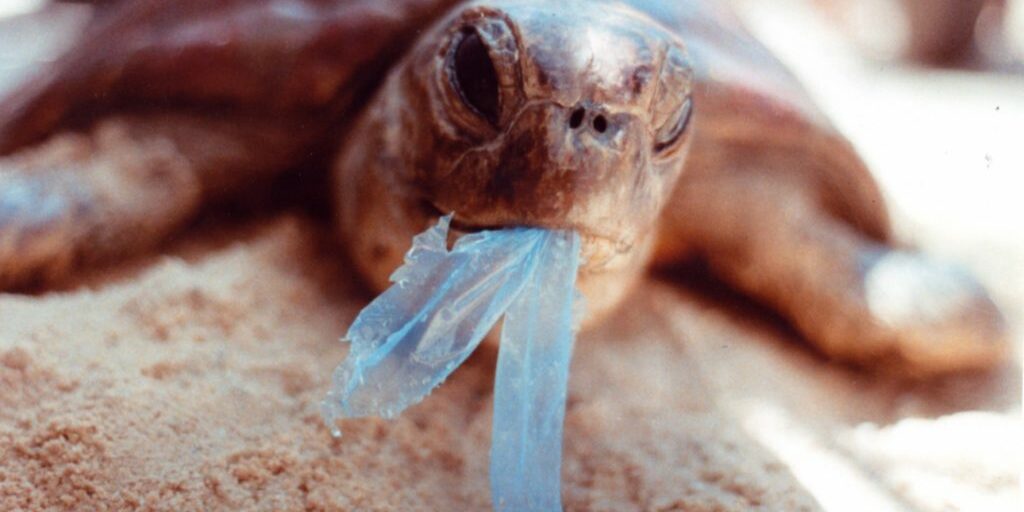Most of us who are into Green Living have now heard of the “Giant Plastic Garbage Patch” in the pacific ocean – a humungous island (the size of Texas,) of plastic, which is has been formed by all our discarded plastic. This plastic finds its way into the ocean where a spirals of water & air currants keep this “island” floating in the middle of the Pacific Ocean. I’ve read extensively about it, and in theory it sounds pretty bad, but when you actually experience its effects first-hand, it becomes horrific. I’m on vacation on the East Coast of Mexico and when I took a long walk down the beach away from the nice eco-friendly hotel I’m staying in, I started to notice a lot of trash on the beach. I assumed that this was an area of the beach that  wasn’t ever cleaned, as there were no large hotels around, however, on closer inspection, in between the larger items of trash (plastic baby bottles, plastic brushes etc,) there was a carpet of something more sinister: I realized that I was looking at a blanket of miniscule pieces of plastic, which is exactly what the Giant Garbage Patch is made up of. This plastic “soup” is obviously washed up on this beach everyday and in this particular area, no one was clearing away the dreadful evidence.
wasn’t ever cleaned, as there were no large hotels around, however, on closer inspection, in between the larger items of trash (plastic baby bottles, plastic brushes etc,) there was a carpet of something more sinister: I realized that I was looking at a blanket of miniscule pieces of plastic, which is exactly what the Giant Garbage Patch is made up of. This plastic “soup” is obviously washed up on this beach everyday and in this particular area, no one was clearing away the dreadful evidence.
 I looked out at the crashing waves and just shuddered to think that there are probably very few places in the world that are untouched by plastic pollution. Plastic, as we all know, doesn’t ever go anywhere. Rather than biodegrade, it is simply broken down into smaller and smaller pieces, which take the place of plankton in the ocean. In some areas of the pacific, the plastic particles outnumber plankton at a ratio of 6-1.
I looked out at the crashing waves and just shuddered to think that there are probably very few places in the world that are untouched by plastic pollution. Plastic, as we all know, doesn’t ever go anywhere. Rather than biodegrade, it is simply broken down into smaller and smaller pieces, which take the place of plankton in the ocean. In some areas of the pacific, the plastic particles outnumber plankton at a ratio of 6-1.
The thing that really broke my heart was directly seeing how the wildlife and marine life was affected. On that awful walk I spotted about 6 giant dead turtles on the beach and at least 5 large birds that couldn’t walk properly. The environment looked and felt “sick”. After asking around, some locals said that the turtles die of pollution, or cruise ships that mow them down, or many of them ingest plastic trash.
Last year I was lucky enough to visit the almost pristine Big Island of Hawaii, where I saw many very healthy turtles. Hawaii is probably as clean as you can get as the islands have a currant washing past and around them all the time. The Hawaiian culture is also incredibly eco-minded, and they’ll do everything they can to preserve their precious environment. Apparently the Mexican culture as far as eco-friendly practices are concerned, is beginning to catch on. Further down the beach I noticed a small turtle preserve that some locals had cobbled together – good for them.
So what can we all do to help this appalling situation? It may seem far away, but pollution is interconnected and affects us all – directly or  indirectly. Recycling isn’t enough. Did you know that 93% of plastics in the U.S. are not recovered or recycled? Even PET plastic, which has a cash redemption value is barely recycled (less than 30%). But the real culprits are single -use plastics: baby products, water/beverage bottles, disposable cutlery, cups, plates, bags etc. Perhaps the most powerful thing we can do as members of this community is to say NO to all single-use plastics from now on. It’s hard to say NO, nigh impossible to say NO to all plastics, but I think every single one of us, with a little thought, can turn our backs on single-use items.
indirectly. Recycling isn’t enough. Did you know that 93% of plastics in the U.S. are not recovered or recycled? Even PET plastic, which has a cash redemption value is barely recycled (less than 30%). But the real culprits are single -use plastics: baby products, water/beverage bottles, disposable cutlery, cups, plates, bags etc. Perhaps the most powerful thing we can do as members of this community is to say NO to all single-use plastics from now on. It’s hard to say NO, nigh impossible to say NO to all plastics, but I think every single one of us, with a little thought, can turn our backs on single-use items.
After that depressing beach walk, I will certainly re-commit to my refusal of single use plastics. When holed up in my insular world back home, it’s all to easy to kind of think that those awful environmental issues are frankly too far away to really matter because they don’t affect my everyday life – but in reality, these kind of issues are coming closer to home. The Giant Garbage Patch isn’t getting any smaller – so think on that!




Thank you for sharing this Sophie, it is so very sad but I agree, it is never too late. Have you come across any good eco friendly disposable cutlery? We could campaign for “caring companies” like Pret a Manger to switch to those. What do Wholefoods Market use in the US?
Was it necessary to show a J. Aniston ad with this? I am the first one to support the effort but you have had a major name back you. Why can’t you just give your facts without thst obvious comparison. It doesn’t feel good to me.
I didn’t take it that way at all. I think the pictues used in this post do a good job of showing the contrast between the glamour of advertising the single use products vs. the ugly and unfortunate result of this consumption.
I think the hardest part of eschewing plastic is the packaging that comes on just about everything! One way to avoid it is to shop at the farmers market for food, make your own cosmetics and cleaning products, and to buy some items secondhand. My Plastic Free Life has been making heroic efforts to avoid plastic and she’s letting the rest of us in on her discoveries: myplasticfreelife.com
ps. I agree with Alison. The pretty ads don’t change the horror behind the consumption.